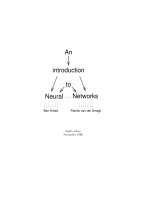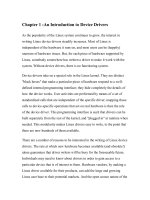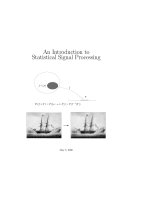An Introduction to Android for Developers ppt
Bạn đang xem bản rút gọn của tài liệu. Xem và tải ngay bản đầy đủ của tài liệu tại đây (1.95 MB, 49 trang )
An Introduction to Android
for Developers
Introduction
Goals
Introduction Goals
•
Get you Started with Android Development
•
Get the Environment Set Up and Working
•
Create Some Demo Apps (Tutorials)
•
Demonstrate the Tools / Environment
•
Introduction to the Documentation
•
(Which is changing )
•
Build Enthusiasm (you can do it)
Introduction Goals
•
Differences from Other Environments
•
UI - Declarative XML Layout
•
Activities
•
Intents / Intent Receivers
•
Services
•
Content Providers
•
Application Life Cycle
•
Project Structure
•
Files, Resources, Building
Tools
•
SDK
•
Command line tools (adb, aidl, etc.)
•
Supporting Libraries
•
IDE (We will use Eclipse)
•
Eclipse Plugin
•
Included:
•
Debugger
•
Profiler
•
Resource Building
•
Deployment
Not Covered
•
Java Development Basics
•
Similarities to Other Environments
•
Parts that Aren’t Ready
•
Syncing etc.
•
Anything We Can’t Get to in time!
•
Get you going, not teach you everything
GUI Creation
/ Layouts
GUI Creation
•
Different from
•
Java Swing
•
Java ME
•
Layouts
•
res/layout - XML Files Go Here
•
Layouts - Can be Nested
•
Strings / i18n
•
res/values/strings.xml
•
Deployment
GUI Creation
•
IDs / Lookup
•
Used to Bridge Views / Java Code
•
@+id/myname Syntax
•
Resource Building
•
Eclipse Plugin Builds into R.java
•
Efficient Resource Creation / Representation
•
Less Chance of Programatic Errors (Intellisense)
•
XML Declarative Faster to Develop
Layout Basics
•
Views
•
Basic Building Blocks
•
TextView, EditText, Button, ImageView,
Checkbox, Lists, etc
•
Layouts
•
FrameLayout : Each Child a Layer
•
LinearLayout : Single Row / Column
•
RelativeLayout : Relative to Parent / Other Views
•
TableLayout : Rows and Columns - HTML like
•
AbsoluteLayout : <x,y> Coords - Discouraged
•
Layouts can be Nested
Layout Parameters
•
Parameters Control Many Aspects
•
Some are More Common:
•
<android:layout_width> and
<android:layout_height>
•
“wrap_content”, “fill_parent”, values
•
<android:layout_weight>
•
Relative amount of available space to use
•
Most are in the Docs
•
Class Reference documentation most useful
When Things Go Wrong
•
Android is still early-release software
•
Most problems fall within two areas
•
Build Problems
•
R class not updated or running old code
•
Look at console and problems pane
•
Clean Build
•
Communication breakdown to emulator
•
Code not deploying, errors, debugger failure
•
Use DDMS Reset ADB option
•
Or: quit eclipse and emulator, adb kill-server
Hello World
Demo
First Project with Eclipse
Layout Experimentation
Android
Concepts
Activities
•
Typically corresponds to one screen in the UI
•
Can be faceless
•
Can be in a floating window
•
Can return a value
•
Can be embedded
Intents & IntentFilters
•
Intents: description of what you want done
•
IntentFilter: what an Activity or
IntentReceiver can do
•
Activities publish their IntentFilters in
AndroidManifest.xml
Intents & IntentFilters
•
Forward navigation is accomplished by
resolving Intents
•
Caller calls startActivity(intent)
(or startSubActivity )
•
System picks Activity whose IntentFilter
best matches intent
•
New Activity is informed of the Intent
IntentReceivers
•
Respond to alarms and notifications
•
Including those originating externally
•
Will wake up your process if necessary
•
System can broadcast intents: data connection,
phone state changed, etc
•
Apps can invent and broadcast their own intents
IntentReceivers
•
IntentReceivers can (should) start Services for
lengthy tasks (e.g. downloading new data)
•
IntentReceivers can put up UI notifications
•
Register IntentReceivers in AndroidManifest.xml
•
Can also attach IntentReceivers to other
objects so they can receive notifications
(Activities, Views, etc.)
Services
•
Faceless classes that run in the background
•
Music player, network download, etc.
•
Services run in your application’s process or
their own process
•
Your code can bind to Services in your process
or another process
•
Once bound, you communicate with Services
using a remotable interface defined in IDL
ContentProviders
•
Enable data sharing across applications
•
Provide uniform APIs to:
•
query data (returns a Cursor)
•
delete, update, and insert rows
•
Hide underlying implementation
•
Work across processes
ContentProviders
•
All content is represented by URIs
•
Convenience methods mean clients don’t
need to know syntax
•
ContentProviders own URIs based on
authority, e.g. content://contacts/
•
ContentProviders are responsible for
mapping URIs they own to a MIME type
Quick Dial
Code
Walkthrough
Eclipse Import + Code
Walkthrough
Life Cycle
& Bundles
Application Lifecycle
•
Applications run in their own processes
•
Many Activities, Services, etc. can run in
the same process
•
Processes are started and stopped as
needed to run an application's components
•
Processes killed to reclaim resources









